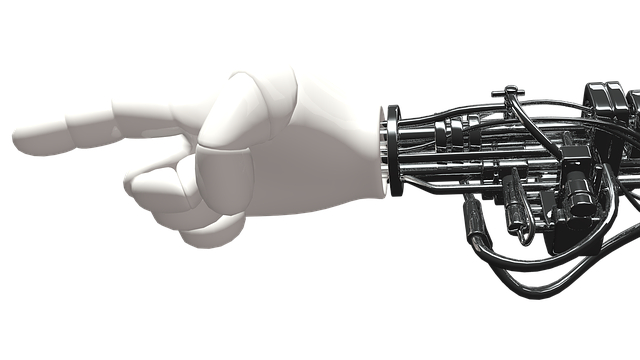
Magnus Johnsson
Cognitive Scientist, Computer Scientist
Haptic Perception

Haptic perception means tactile perception gained by active tactile exploration, i.e. in contrast to passive touch perception an active exploration by, for example, a hand or a finger is carried out in order to gain tactile sensory information about the explored object. One example is when you blindfolded carry out a sequence of differently oriented grasps around a particular object with your hand to understand its shape. Another example is when it is pitch dark and you grope around with your hand against a door to find out where the doorknob is and how it is oriented so that you can operate it properly.
What biological mechanisms underlie touch perception and active tactile exploration, and how could something similar be implemented in robots? This is something I have addressed extensively in my research on haptic perception. I have designed and implemented a number of bio-inspirerad self-organizing robot systems that implement different aspects and submodalities of artificial touch perception and the interplay between them, exploiting different kinds of tactile sensory information like proprioceptive information of the robot's joints, pressure information gained through the robot's contact with the objects, and information gained about material properties of the objects, like hardness and roughness.
A number of robot platforms have been designed and implemented for this aim, and I have addressed, for example, the perception of size and shape of the actively explored objects as well as the perception of the hardness and the roughness of the materials the objects are composed of through haptic perception, as well as combined systems.
Some Related Publications
Johnsson, M. and Balkenius, C. (2011). Sense of Touch in Robots with Self-Organizing Maps. IEEE Transactions on Robotics, 27, 3, 498-507.
Johnsson, M., and Balkenius, C. (2010). Haptic Perception with Self-Organizing ANNs and an Anthropomorphic Robot Hand. Journal of Robotics, vol. 2010, Article ID 860790, 9 pages.
Johnsson, M., and Balkenius, C. (2009). Experiments with Self-Organizing Systems for Texture and Hardness Perception. Global Journal of Computer Science and Technology, 1.2, 53-62.
Johnsson, M. (2009). Sense of Touch in Robots. An investigation into how a sense of touch could be implemented in robots. PhD thesis from the Dept. of Cognitive Science, Lund University.
Johnsson, M., and Balkenius, C. (2008). Recognizing Texture and Hardness by Touch. In Proceedings of the 2008 IEEE International Conference on Intelligent Robots and Systems (IROS 2008), Nice, France, 482-487.
Johnsson, M., and Balkenius, C. (2008). Associating SOM Representations of Haptic Submodalities. In Ramamoorthy, S. and Hayes, G. M. (Eds.) Towards Autonomous Robotic Systems 2008, The University of Edinburgh, Edinburgh, UK, 124-129.
Johnsson, M., Gil Mendez, D., and Balkenius, C. (2008). Touch Perception with SOM, Growing Cell Structures and Growing Grids. In Ramamoorthy, S. and Hayes, G. M. (Eds.) Towards Autonomous Robotic Systems 2008, The University of Edinburgh, Edinburgh, UK, 79-85.
Johnsson, M., & Balkenius, C. (2007). Neural Network Models of Haptic Shape Perception. Journal of Robotics and Autonomous Systems, 55, 720-727.
Johnsson, M., & Balkenius, C. (2007). Experiments with Proprioception in a Self-Organizing System for Haptic Perception. In Wilson, M., S., Labrosse, F., Nehmzow, U., Melhuish, C., Witkowski, M. (Eds.) Towards Autonomous Robotic Systems 2007, University of Wales, Aberystwyth, UK, 239-245.
Johnsson, M., & Balkenius, C. (2006). Experiments with Artificial Haptic Perception in a Robotic Hand. Journal of Intelligent and Fuzzy Systems, 17, 4, 377-385.
Johnsson, M., & Balkenius, C. (2006). A Robot Hand with T-MPSOM Neural Networks in a Model of the Human Haptic System. In Witkowski, M., Nehmzow, U., Melhuish, C., Moxey, E. and Ellery, A. (Eds.) Towards Autonomous Robotic Systems 2006, Surrey University, Guildford, UK, 80-87.
Johnsson, M., & Balkenius, C. (2006). Haptic Perception with a Robotic Hand. In Honkela, T., Raiko, T., Kortela, J. and Valpola, H. (Eds.) Proceedings of the Ninth Scandinavian Conference on Artificial Intelligence (SCAI 2006), Helsinki University of Technology, Espoo, Finland, 127-134.
Johnsson, M., Pallbo, R., & Balkenius, C. (2005). A Haptic System for the LUCS Haptic Hand I. In Mira, J., and Alvarez, J.R. (Eds.), Mechanisms, Symbols, and Models Underlying Cognition: First International Work-Conference on the Interplay Between Natural and Artificial Computation, IWINAC 2005, Las Palmas, Canary Islands, Spain, June 15-18, 2005, Proceedings, Part I, 386-395. Springer-Verlag.
Johnsson, M., Pallbo, R., & Balkenius, C. (2005). Experiments with Haptic Perception in a Robotic Hand . In Funk, P., Rognvaldsson, T., and Xiong, N. (Eds.) Advances in Artificial Intelligence in Sweden, Västerås, Sweden: Mälardalen University, 81-86.